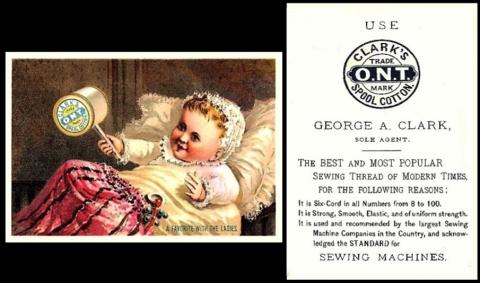
The main reason for this card is that the cotton reel is being pressed into service as a rattle, and a rattle is the earliest known child`s plaything of all, its purpose being to amuse with sound. The oldest rattle in existence was been found in Turkey - and it is 4,200 years old.
The card was issued by George A. Clark, and the A stands for Aitken. His father, John Clark, was a thread retailer, and maker, already, in Paisley, Scotland, as had been his family before him, and he also supplied looms and related equipment. This thread had once been silk, but that came from France, and during the Napoleonic Wars it was almost impossible to acquire. The Clarks at that time had a plan, for they had a fairly large stock of silk thread, and equipment, and what they did was to find a way of splitting the silk thread into smaller strands and combining it with the easier to acquire cotton thread. It must have been a very hard job to do this, but it had two benefits, apart from being able to stay in business. The first of these was that it saved some of the usual costs of all silk thread - but the second was that it had the soft feel and core strength of silk along with the matte finish of cotton which stops it showing up on certain fabrics. It was at this point that the Clark trademark of "O.N.T." began - and it simply means "Our New Thread"
In 1790 the first "sewing machine" had been invented, it was hand cranked and definitely designed for heavy duty, industrial work of leather and canvas, not for home sewing of clothes. Or at least one was patented, because there is no record that any were produced at the time. This was almost forty years after a patent for a needle to fit into a machine and allow it to reproduce hand sewing - without any mention of the machine it was going to fit. The first working sewing machine was made in France in 1830, seven years after John Clark`s son, our George A. Clark, was born in August 1823.
Little is known of his early life but in 1840 when he was seventeen he was sent right across the Atlantic in order to work for Kerr & Co.in Ontario, Canada. They would be bought out by J & P Coats almost fifty years later. He then returned home to Paisley, so this could have been an apprenticeship? Or is there a clue in the fact that in 1851 he went into business with his brother in law, a Mr. Robert Kerr, making thread.
The partnership did well, with international trading too, and so in 1864 they decided to acquire premises in Newark, New Jersey. Some of this decision was to reduce the general costs of shipping, but there were also changes in the tax laws which having a foreign premises would avoid.
The company was a great success, so much so that in 1866 they incorporated George Clark`s family firm, and became Clark & Co. However George Clark died less than ten years later, in 1873.
Now the important thing about this card is that it has the name of George A. Clark but below the circular logo is his name and the words "Sole Agent". That must mean that it dates from a time when he was selling the family product, but had not yet amalgamated his company with theirs, so some time between 1851 and 1866.
Unless anyone knows different?
